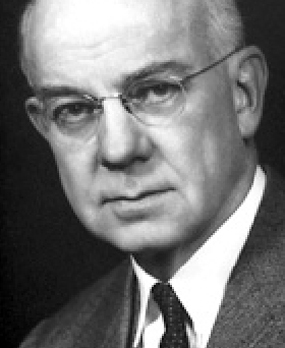How has he transformed the scene?
Dr. Edward Kendall’s research career at the Mayo Foundation was distinguished by a string of breakthroughs, the first of which was isolation of thyroxine (the hormone of the thyroid gland). He also worked with associates to crystallize the tripeptide glutathione and determine its structure, as well as to isolate numerous compounds—most notably, cortisone—from the adrenal cortex. This latter work resulted in his receipt of a Nobel Prize shared with Mayo colleague Dr. Philip Hench, who with Kendall demonstrated the therapeutic use of cortisone in arthritis and other diseases of an inflammatory nature.
“His greatness lay in his ability to select important goals that were achievable, to persevere toward them during periods of adversity and disappointment, and to select gifted associates.”
Dwight J. Ingle (in) Edward C. Kendall, Biographical Memoirs
Described as a man of “noble aims and tenacity,” Kendall is said to have spent the greater part of his professional life standing before a lab bench. Of the three functions of the Section of Biochemistry at the Mayo Foundation—graduate education, clinical biochemistry and basic research—Kendall was most keenly interested in the discoveries to be made through basic research. In this, he was fortunate that the Mayo brothers, Drs. Will and Charlie Mayo, were similarly intrigued by the mysteries of the endocrine system—and were steadfast in their support of his pursuits.
In the scientific literature, Kendall’s name will always be associated with the crystallization of thyroxine, a discovery that occurred soon after he began his association with Mayo. According to Kendall biographer and former colleague Dwight Ingle, the discovery was effectively made on Christmas day of 1914 when Kendall precipitated crystals of the pure compound from a “white crust” formed when he had inadvertently fallen asleep in the lab while evaporating ethanol from iodothyin, a partially purified extract of hog thyroid gland. Despite years of subsequent investigations, the structure of thyroxine would elude Kendall. In 1926, London-based researcher Dr. C. R. Harrington would be the first to determine its structure and devise means of synthesis.
Kendall’s skills as an extractionist would later lead to momentous discoveries on a different research horizon: the adrenal cortex. As the 1920s came to a close, physiologists were demonstrating use of cortical extracts in successful treatment of patients with Addison’s disease (an adrenal insufficiency). Still, the active factor had not been determined. Kendall’s team at Mayo became one of many around the world to take on the challenge. Concurrently and independently, several of these labs (including Kendall’s as well as the Switzerland laboratory of chemist Dr. Tadeus Reichstein) were eventually successful in isolating a remarkable 28 compounds from the adrenal cortex, all steroids. Four of these warranted particular interest due to what Kendall described as their “physiologic activity.”
Soon there would be heightened interest in their research from an unexpected source: the military. In 1941, wartime intelligence reported (wrongly, as it turns out) that hormones from adrenal extracts were being used by Luftwaffe pilots to increase their ability to withstand higher altitudes. At the request of military medical departments, the National Research Council of the United States requested that qualified labs and manufacturers quickly find ways to produce high volumes of adrenal hormones. Efforts ramped up to synthesize the four most promising compounds (called A, B, E, and F) in hopes of enabling large-scale production.
By 1944 Kendall’s group had devised a method for laboratory preparation of compound A without using adrenal glands as a starting point. The method would later be adapted by Dr. Lewis Sarret in the laboratories of Merck and Co., Inc to synthesize Compound E, creating potential for its future production on a factory scale. It was by then known that the wartime rumors of hormone-fueled pilots were just that: rumors. But the larger question remained—might there be clinical applications for these compounds other than the treatment of Addison’s disease?
The stage was set for Dr. Kendall and Mayo colleague Dr. Philip Hench to run a clinical trial they had sought for years to undertake. Hench, a rheumatologist, had long suspected that an agent existed—perhaps a substance naturally produced in the body—that could reverse rheumatoid arthritis. [See Hall of Fame profile, Dr. Philip Hench.] In consultation, Hench and Kendall had agreed that “Compound E” was worthy of a trial. The first few grams of synthesized Compound E were produced in May of 1948. By September of that year, at Hench’s urging, Kendall was able to procure sufficient supply to run a limited trial at Mayo. They administered the first injection of the hormone to a patient with rheumatoid arthritis. The result, further demonstrated in additional patients, was a striking and profound improvement in mobility and level of pain.
It was not a cure, and there would later prove to be drawbacks to its long-term use. But this major new therapy for inflammation—dubbed cortisone—was now available to the world. For their efforts, Kendall and Hench received a Nobel Prize (shared with Dr. Reichstein) in 1950 for discoveries concerning hormones of the adrenal cortex, their structure, and biological effects.
The following year, 1951, Kendall retired from the Mayo Clinic to become a visiting professor at Princeton University, where his work on the adrenal cortex continued. He died in 1972.
In his writings and speaking engagements Kendall was quick to credit those who contributed to his successes, citing his able colleagues at Mayo as well as those in the broader scientific community upon whose work his research was grounded. Ever cognizant of the mysteries yet to be solved, he was also quick to see his own accomplishments in perspective. Having achieved a premier honor for his work as a scientist, he took the occasion of his Nobel Prize lecture to quote Shakespeare’s soothsayer, offering: “In Nature’s infinite book of secrecy a little I can read.”

